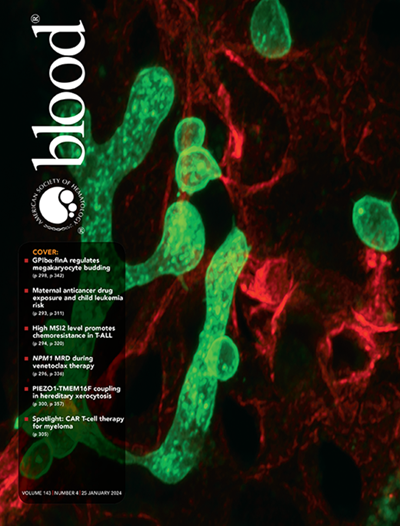在一项大型临床试验中,赞成与临床医生报告的不良事件:来自3期POLARIX研究的结果
IF 23.1
1区 医学
Q1 HEMATOLOGY
引用次数: 0
摘要
弥漫性大b细胞淋巴瘤(DLBCL)由于其多种症状,以及疾病和治疗对健康相关生活质量(HRQoL)影响之间复杂的相互作用,对血液学提出了挑战。POLARIX 3期研究(NCT03274492)显示,polatuzumab vedotin联合利妥昔单抗、环磷酰胺、阿霉素和泼尼松(Pola-R-CHP)与利妥昔单抗、环磷酰胺、阿霉素、文新碱和泼尼松(R-CHOP)在先前未经治疗的DLBCL患者中的无进展生存期(PFS)和类似的安全性。在这里,我们通过患者报告的结果(PRO)工具来评估HRQoL,以充分表征POLARIX研究中的患者体验。通过pro和临床报告的不良事件(ae)来评估HRQoL、淋巴瘤症状和胃肠道(GI)症状的基线变化,以及常见症状的发生率和严重程度。可pro评估患者(N = 874)的基线特征是一致的。PROs与临床报告ae的比较显示出明显的不一致;患者通常报告的症状发生率高于临床医生,强调需要以患者为中心的工具来准确捕捉患者体验。两种治疗方法在HRQoL和淋巴瘤症状方面均表现出快速和持续的改善,其中在总体健康状况/QoL、淋巴瘤症状、疲劳、角色、情绪和社会功能方面的改善最为显著。胃肠道症状(腹泻、便秘、恶心和呕吐)在治疗组之间基本相似,并在治疗完成后恢复到基线水平。这些HRQoL数据强调了PROs作为临床报告ae的补充,在评估新疗法(包括Pola-R-CHP)的疗效和耐受性方面的互补性,这可能代表了先前未治疗的DLBCL患者报告HRQoL的新基准。本文章由计算机程序翻译,如有差异,请以英文原文为准。
PROs vs clinician-reported adverse events in a large clinical trial: findings from the phase 3 POLARIX study.
Diffuse large B-cell lymphoma (DLBCL) poses a challenge in hematology given its varied symptoms, and the complex interplay between disease and treatment effects on health-related quality of life (HRQoL). The phase 3 POLARIX study (NCT03274492) demonstrated superior progression-free survival (PFS) and a similar safety profile with polatuzumab vedotin plus rituximab, cyclophosphamide, doxorubicin and prednisone (Pola-R-CHP) vs rituximab, cyclophosphamide, doxorubicin, vincristine and prednisone (R-CHOP) in patients with previously untreated DLBCL. Here, we evaluate HRQoL through patient-reported outcome (PRO) instruments to fully characterize the patient experience in the POLARIX study. Changes from baseline in HRQoL, lymphoma symptoms, and gastrointestinal (GI) symptoms were assessed, as well as incidence and severity of common symptoms by PROs vs clinician-reported adverse events (AEs). Baseline characteristics of PRO-evaluable patients (N = 874) were consistent. Comparison between PROs and clinician-reported AEs revealed a notable discordance; patients generally reported a higher incidence of symptoms than clinicians, emphasizing the need for patient-centric tools to accurately capture the patient experience. Both treatments exhibited rapid and sustained improvements in HRQoL and lymphoma symptoms, with the most substantial improvements seen in global health status/QoL, lymphoma symptoms, fatigue, role, emotional, and social functioning. GI symptoms (diarrhea, constipation, nausea, and vomiting) were generally similar between treatment arms and returned to baseline levels after treatment completion. These HRQoL data underscore the complementarity of PROs, as an adjunct to clinician-reported AEs, in evaluating the efficacy and tolerability of new treatments, including Pola-R-CHP, which may represent a new benchmark for patient-reported HRQoL in previously untreated DLBCL.
求助全文
通过发布文献求助,成功后即可免费获取论文全文。
去求助
来源期刊

Blood
医学-血液学
CiteScore
23.60
自引率
3.90%
发文量
955
审稿时长
1 months
期刊介绍:
Blood, the official journal of the American Society of Hematology, published online and in print, provides an international forum for the publication of original articles describing basic laboratory, translational, and clinical investigations in hematology. Primary research articles will be published under the following scientific categories: Clinical Trials and Observations; Gene Therapy; Hematopoiesis and Stem Cells; Immunobiology and Immunotherapy scope; Myeloid Neoplasia; Lymphoid Neoplasia; Phagocytes, Granulocytes and Myelopoiesis; Platelets and Thrombopoiesis; Red Cells, Iron and Erythropoiesis; Thrombosis and Hemostasis; Transfusion Medicine; Transplantation; and Vascular Biology. Papers can be listed under more than one category as appropriate.
 求助内容:
求助内容: 应助结果提醒方式:
应助结果提醒方式:


